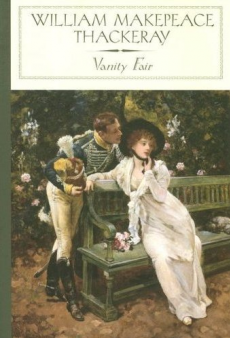
This book is one of the masterpieces of the Victorian era. Written by an author called William Makepeace Thackeray, it makes a joke of haughty English society in the 18th century. Unlike many other books written by male authors of the time, there are two female protagonists, and both women have complicated personalities. However, don’t go away thinking Thackeray is a feminist – some of the comments he makes in the book aren’t fair on women at all!
Our story centres around Becky Sharp and Amelia Sedley. Their names suggest something about who they are as people – Becky Sharp is more common and “sharp”, and Amelia is better-bred and softer. They became friends at school, and when they have to go into the real world afterwards, they often end up on different sides. The plot shows the reader how unfair the world is to women, especially poor women. But it also makes scathing comments about how women act in society, and about society in general.
We start at Amelia’s and Becky’s school, London society, the good times, the bad times, and war. The book basically has a happy ending, but I won’t tell you what it is yet. It’s almost 700 pages long, but once you get into it, you’ll be unable to put the book down. You’ll love some of the characters, and be rooting for them the whole way through, and you’ll really detest some others. I almost wish I hadn’t finished the book, so I can pick it up again and read about my favourite characters!
So, we already know a bit about Becky and Amelia, but they’re still worth exploring. Becky is born to a poor artist, and has to be harsh in order to make money and survive. She is beautiful, witty, and very cunning. She meets Amelia Sedley at school, a sweet classmate with a wealthy and stable family. There are many male characters in the story, but the ones you’ll care about are George, Amelia’s husband, and William Dobbin, Amelia’s loyal friend. Dobbin is the personification of goodness, and you’ll probably fall in love with him. I did – I hope he asks me to marry him soon!
The story isn’t told in the first person, and it’s not told in the third person either. It’s told by a person loosely connected to the story and the characters, and he shares some insights about the private lives of certain people. This was an unusual technique at the time, and although for us it’s engaging, at the time it wasn’t always popular. It slated human nature so much that people thought it was too pessimistic.
These days, people speculate and wonder about the ending of the novel, which is left a little bit open-ended. The reader has lots of questions, and might not feel satisfied with the ending, but I guess you’ll just have to read it to find out. Maybe you’ll be able to place yourself in the rollercoaster ride of Vanity Fair – after all, we all must take our place in society.
Image credit: http://www.annarbor.com/entertainment/books/truly-a-novel-without-a-hero-vanity-fair/

0 Comment:
Be the first one to comment on this article.